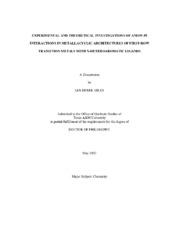| dc.description.abstract | Research into anion-pi interactions has shifted from attempts to establish the legitimacy of the interaction to the incorporation of anion-pi interactions into supramolecular architectures. The research discussed in this dissertation explores the subtle effects of ligand, anion, and metal ion on supramolecular architectures of tetrazine-based ligands in the context of anion-pi interactions and their importance in the design and synthesis of supramolecular architectures.
Computational studies highlight the importance of the arene quadrupole moment, molecular polarizability, and substituent effects on the strength of anion-pi interactions. More importantly, however, this work establishes that there is a distinct directionality inherent to the anion-pi interaction between polyatomic anions and N-heterocycles, which can be used to direct ligands in supramolecular architectures as demonstrated through the work of the Dunbar group in recent years, particularly that of the square and pentagonal metallacycles.
The extension of metallacycles of bptz to CoII and FeII demonstrates the ability to tune the size of the metallacyclic cavity by simply changing the metal ion and results in the surprising encapsulation of two [SbF6]- anions in [Fe5(bptz)5(NCCH3)10][SbF6]10. 1H NMR spectroscopy and electrochemical studies reveal slight but significant differences characteristic of the square and pentagonal metallacycles and support the presence of anion-pi interactions in solution and highlight the importance of the encapsulated anion in the templation and stability of the metallacycles. A study of the interconversion between the square and pentagonal metallacycles via 1H NMR is presented for the first time.
Increasing the pi-acidity of the chelating ligand from bptz to bmtz results in the encapsulation of only one [SbF6]- anion in [Fe5(bmtz)5(NCCH3)10][SbF6]10, maximizing anion-pi interactions with the ligand despite the tighter fit. A significant hurdle in the incorporation of different anions into the metallacyclic structures was overcome with the development of a new synthetic protocol for [Fe(NCCH3)6]2+ salts of a wide range of anions from sodium salts and Fe4Cl8(THF)6. Also, the nuclearity of the less stable [Fe5(bptz)5(NCCH3)10][PF6]10 metallacycle was established via a combination of MS, electrochemistry and 1H NMR experiments through comparisons with known FeII metallacycle solution behavior. | en |


